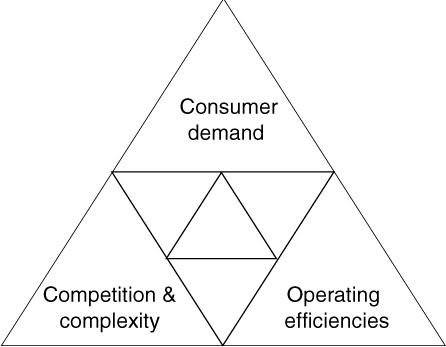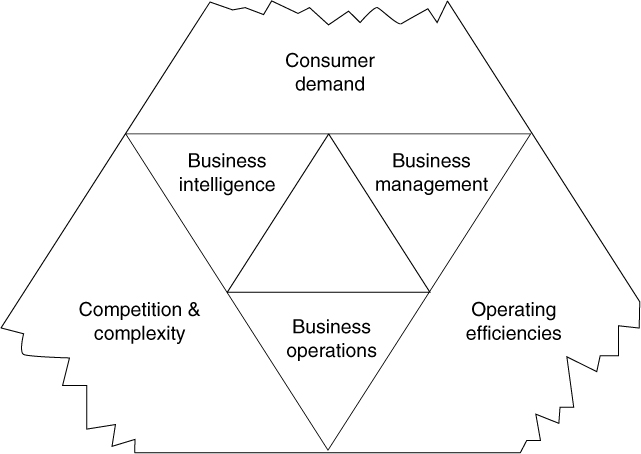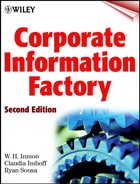CHAPTER 1
Creating an Information Ecosystem
Business is quickly reshaping itself to compete in a global economy governed by the needs of the customer (e.g., individual, business, etc.). The economies gained over the past three decades by automating manual business processes are no longer enough to gain a competitive advantage in today’s marketplace. To compete, businesses need to be able to build a new set of capabilities that deliver best-of-breed business intelligence and business management solutions that can leverage this legacy environment.
But wait! Perhaps the genesis is already upon us. Your IT department is being bombarded with a growing number of targeted information architectures, technologies, methodologies, terms, and acronyms. Each of these advances promises to deliver competitiveness in one easy step, such as:
![]() Data warehousing
Data warehousing
![]() Data repository
Data repository
![]() Operational data store
Operational data store
![]() Data marts
Data marts
![]() Data mining
Data mining
![]() Internet and intranet
Internet and intranet
![]() Multidimensional and relational databases
Multidimensional and relational databases
![]() Exploration processing
Exploration processing
![]() Star schema, snowflake, and relational database design techniques
Star schema, snowflake, and relational database design techniques
![]() High-performance computing (Massively Parallel Processing & Symmetrical Multiprocessing)
High-performance computing (Massively Parallel Processing & Symmetrical Multiprocessing)
![]() Data acquisition and data delivery
Data acquisition and data delivery
![]() Online Analytical Processing (OLAP)
Online Analytical Processing (OLAP)
![]() Data warehouse administration
Data warehouse administration
![]() Metadata management
Metadata management
Each of these advances in modern information technology has promise, but trying to make sense of these point solutions while still getting the job done in a short time frame can be confusing and intimidating. This is largely due to the fact that no model exists that combines these elements of the information primordial pool into a balanced ecosystem that aligns with the evolving needs of the business. An information ecosystem is needed to orchestrate the use of various information technologies and constructs and to foster communication and the cooperative exchange of work, data processing, and knowledge as part of a symbiotic relationship.
Information Ecosystem Briefly Defined
An information ecosystem is a system with different components, each serving a community directly while working in concert with other components to produce a cohesive, balanced information environment. Like nature’s ecosystem, an information ecosystem must be adaptable, changing as the inhabitants and participants within its aegis change. Over time, the balance between different components and their relationship to each other changes as well, as the environment changes. Sometimes the effect will appear on seemingly unrelated parts (sometimes disastrously!). Adaptability, change, and balance are the hallmarks of the components of a healthy information ecosystem.
As an example of an information ecosystem, consider a data warehouse working with a data mart to deliver business intelligence capabilities or an operational data store working to deliver business management capabilities. This environment is found in many marketing groups. At first, there is the need for better business intelligence in the form of market segmentation, customer analysis and contact analysis. Then, at some point, marketing wants to take action on the “intelligence” gained. Although the data warehouse and data mart are well suited to support business intelligence, they lack the content and form to drive business-management activities associated with contacting the customer. What is needed is an operational data store to provide near real-time access to integrated, current customer information.
As will be discussed in this book, different business needs require that a different set of ecosystem components work in tandem. Ultimately, the information ecosystem will be business-driven, as capabilities delivered (business intelligence and business management) are aligned with the needs of the business (marketing, customer service, product management, etc.). The result is an information environment that allows companies to capitalize on a constantly changing business landscape characterized by customer relationships and customized product delivery.
Shifting Business Landscape
Three fundamental business pressures are fueling the evolution of the information ecosystem: growing consumer demand, increased competition and complexity, and continued demands for improvements in operating efficiencies as seen in Figure 1.1.
Consumer Demand
The first fundamental pressure is growing consumer demand. Consumers expect companies to understand and respect their needs and desires. Because the customer drives the business relationship, business people must hear what the customer has to say and respond by delivering relevant, competitive, and timely products and services. Companies can no longer expect to sell just a few general products and services to the masses but must tailor many products and services (i.e., mass customize) to the individual consumer. This proposition is called customer relationship management and/or mass customization. The fundamental challenge to many businesses is that their systems, people, and processes are designed around the product. Furthermore, most of these companies have begun to extend these environments with a series of unarchitected point solutions to address their immediate needs for customer management. A healthy information ecosystem will be embodied by an architecture that:
![]() Leverages this legacy environment
Leverages this legacy environment
![]() Delivers new information capabilities that allow companies to thrive in an environment characterized by customer relationships and customized product delivery
Delivers new information capabilities that allow companies to thrive in an environment characterized by customer relationships and customized product delivery
![]() Supports a migration strategy that is evolutionary in nature and delivers incremental value to the business
Supports a migration strategy that is evolutionary in nature and delivers incremental value to the business

Figure 1.1 The business drivers in today’s world.
Competition and Complexity
The second business pressure is that of increased competition and complexity. The ability to refocus and enhance a product mix in response to evolving competition is a critical success factor for any business. The key is to be able to anticipate the needs of the marketplace before your competitors do. Many companies find this difficult or impossible to do, given today’s mishmash of technologies, architectures, and systems.
Why is this important? Corporations today are facing more and more deregulation, mergers, and acquisitions, which blur the relationships with their customers. Additionally, globalization of the marketplace and the consumer is opening up businesses to new avenues for expansion and, subsequently, competition. Therefore, it is mandatory for a corporation to quickly restructure itself without losing the ability to compete.
Operating Efficiencies
The third pressure is that of continued improvements in operating efficiencies. The ability to rapidly measure and predict returns on investment is something that corporations find difficult to perform. These measurements indicate the health of the corporation, and the ability to determine them rapidly allows a corporation to change its direction with a minimal loss in time or money. Other examples of improved efficiency include the ability to determine the most efficient channels for contacting customers, to target the best product mix to the best customers, and to identify new product opportunities before the competition does.
Responding to Change
In response to these very real business challenges, companies must be able to support more than just classical business operations (legacy systems that automate manual business processes such as billing, order processing, etc.). Competitive corporations need capabilities to support business intelligence and business management. In this way, they can respond to the dynamics of a quickly changing business landscape, as seen in Figure 1.2.
The information ecosystem provides a context for understanding the needs of your business and taking actions based on those needs while still running the day-to-day business. Additionally, the information ecosystem provides businesses with a comprehensive model for leveraging the growing number of distinctive information constructs and technologies that are required to deliver diverse and pressing business capabilities to support these needs. Figure 1.3 illustrates the central role of the corporate information factory in supporting the evolving areas of business proficiency: business operations, business intelligence, and business management.

Figure 1.2 The need for business capabilities to compete in a quickly changing business landscape.

Figure 1.3 The corporate information factory is central to a business and its needed capabilities.
Business operations are supported by capabilities used to run the day-to-day business. These systems have traditionally made up our legacy environment and have provided a competitive advantage by automating manual business processes to gain economies of scale and speed-to-market. Systems that exemplify business operations include accounts payable, accounts receivable, billing, order processing, compensation, and fulfillment/distribution.
Business intelligence is supported by capabilities that help companies understand what makes the wheels of the corporation turn and help predict the future impact on current decisions. These systems play a key role in the strategic planning process of the corporation. Systems that exemplify business intelligence include medical research, market analysis, customer contact analysis, segmentation, scoring, profitability forecasting, and inventory forecasting.
Business management is supported by capabilities that are needed to effectively manage actions resulting from the business intelligence gained. If business intelligence helps companies understand what makes the wheels of the corporation turn, business management helps direct the wheels as the business landscape changes. These systems are characterized by robust real-time reporting and tight integration with business intelligence and business operations systems. Systems that exemplify business management include fulfillment management, channel management, inventory management, resource management, and customer information management. These systems generally augment and/or evolve from business operations.
In summary, the information ecosystem provides companies with a complete information solution by complementing traditional business operations with capabilities to deliver business intelligence and business management. In addition, the information ecosystem provides a comprehensive model for making sense and exploiting the growing and diverse information constructs and technologies that are transforming our information paradigm. The physical embodiment of the information ecosystem is the corporate information factory.
Corporate Information Factory
First introduced by W. H. Inmon in the early 1980s, the corporate information factory (CIF) is the physical embodiment of the notion of an information ecosystem. The CIF is at the same time generic in its structure (to the point that it is easily recognizable across different corporations) and is unique to each company as it is shaped by business, culture, politics, economics, and technology. The corporate information factory is made up of the following components:
External world. It is the businesses and people who generate the transactions that fuel the CIF and who produce and benefit from the information produced.
Applications. Applications are the family of systems from which the corporate information factory gathers raw detail data. There are two types of applications: integrated and unintegrated. Integrated applications represent those systems that have been developed according to the guidelines set forth by the corporate information factory. Unintegrated applications are traditionally represented by those core operational systems that have been used to drive day-to-day business activities like order processing, accounts payable, etc. Over time, these unintegrated applications will become integrated as their role transcends beyond traditional business operations to support business management.
Operational data store. It is a subject-oriented, integrated, current-valued, volatile collection of detailed data used to support the up-to-the-second collective tactical decision-making process for the enterprise.
Integration and transformation layer. This is where the data gathered by the applications is refined into a corporate structure.
Data warehouse. It is a subject-oriented, integrated, time-variant (temporal), and nonvolatile collection of summary and detailed data used to support the strategic decision-making process for the enterprise.
Data mart(s). It is a customized subset of data from the data warehouse tailored to support the specified analytical requirements of a given business unit.
Internet/intranet. These are the lines of communication along with data flows and different components that interact with each other.
Metadata. It is the information catalog infrastructure to the CIF. This catalog provides the necessary details to promote data legibility, use, and administration.
Exploration and data mining warehouse. This is where the explorer can go to do analysis and does not have to think about the impact on the resources.
Alternative storage. It is where “overflow” and “bulk” storage can be used, extending the warehouse to infinity. The costs of warehousing are greatly mitigated by moving masses of data to alternative storage.
Decision support systems. These systems are a whole body of applications whose center of existence is the data warehouse. These applications are large and distinctive enough that they form their own component of the corporate information factory.
The different components of the CIF create a foundation for information delivery and decision-making activities that can occur anywhere in the CIF. Many of these activities are in the form of decision-support systems (DSS) that provide the end user with easy-to-use, intuitively simple tools to distill information from data.
People and Processes
The people and processes that work within the structure of the information ecosystem represent the roles, workflow, methods, and tools used in constructing, managing, and using the corporate information factory. Activities that occur here include:
![]() Customer communications (newsletters, surveys, etc.)
Customer communications (newsletters, surveys, etc.)
![]() Request management (logging, prioritizing, and managing)
Request management (logging, prioritizing, and managing)
![]() Delivery of information (data mart enhancements, corrections)
Delivery of information (data mart enhancements, corrections)
![]() Configuration management (versioning of metadata, database design, extraction, programs, transformation programs, etc.)
Configuration management (versioning of metadata, database design, extraction, programs, transformation programs, etc.)
![]() Data quality management (performing audits, integrity checks, alerts)
Data quality management (performing audits, integrity checks, alerts)
![]() Systems administration (determining capacity, conducting performance tuning, etc.)
Systems administration (determining capacity, conducting performance tuning, etc.)
The people and processes of the CIF are perhaps one of the more difficult issues for a corporation because, in planning this function, the corporation must take into consideration its culture, politics, economics, geography, change, and other concerns. For example, companies that have traditionally managed their information systems from a central organization may have challenges supporting data marts that are owned and managed by line-of-business information systems personnel. Alternatively, organizations that have managed information systems at the line-of-business level may have problems giving up the control necessary to form an information systems group to build and manage a corporate data warehouse.
The nature of these variables makes this function a much more customized one for the enterprise and, therefore, harder to implement. There is less uniformity across different corporations in how this aspect of the information ecosystem is implemented than perhaps anywhere else.
Summary
The information ecosystem is a model that supports all of a corporation’s information processing. The physical embodiment of the information ecosystem is the corporate information factory. The different components of the corporate information factory have been introduced and defined briefly to give the information systems (IS) architect an idea of how they fit into the overall architecture. Each component must be in balance with the others to avoid a malfunctioning environment, much like nature’s ecosystem.
The forces of business coupled with the advances in technology and the symbiotic relationship of technology to the business process cause the world of technology to constantly evolve. In years past when technology was slow and expensive, there was no opportunity for the sophistication that is possible today. But with the decreasing cost of technology, the increasing speed, and new capacities, there are possibilities for the exploitation of technology in the business equation as never before. At the heart of these possibilities is an evolving architecture that has become increasingly apparent, the corporate information factory. It has evolved from many systems and technologies now found in the world of corporate information processing.
In the next chapter, we will take a closer look at the corporate information factory, its use, and its evolution.
